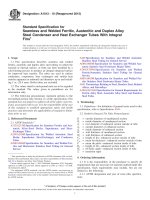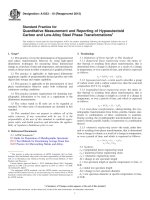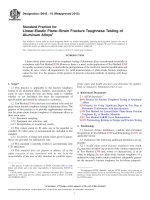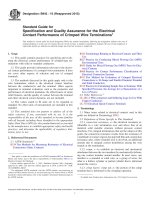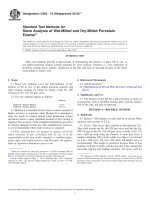Astm e 1597 10 (2015)
Bạn đang xem bản rút gọn của tài liệu. Xem và tải ngay bản đầy đủ của tài liệu tại đây (75.38 KB, 3 trang )
Designation: E1597 − 10 (Reapproved 2015)
Standard Test Method for
Saltwater Pressure Immersion and Temperature Testing of
Photovoltaic Modules for Marine Environments1
This standard is issued under the fixed designation E1597; the number immediately following the designation indicates the year of
original adoption or, in the case of revision, the year of last revision. A number in parentheses indicates the year of last reapproval. A
superscript epsilon (´) indicates an editorial change since the last revision or reapproval.
1. Scope
E772 Terminology of Solar Energy Conversion
E1036 Test Methods for Electrical Performance of Nonconcentrator Terrestrial Photovoltaic Modules and Arrays
Using Reference Cells
E1328 Terminology Relating to Photovoltaic Solar Energy
Conversion (Withdrawn 2012)3
E1462 Test Methods for Insulation Integrity and Ground
Path Continuity of Photovoltaic Modules
1.1 This test method provides a procedure for determining
the ability of photovoltaic modules to withstand repeated
immersion or splash exposure by seawater as might be encountered when installed in a marine environment, such as a
floating aid-to-navigation. A combined environmental cycling
exposure with modules repeatedly submerged in simulated
saltwater at varying temperatures and under repetitive pressurization provides an accelerated basis for evaluation of aging
effects of a marine environment on module materials and
construction.
3. Terminology
3.1 Definitions—Definitions of terms used in this test
method may be found in Terminology E772 and Terminology
E1328.
3.2 Definitions of Terms Specific to This Standard:
3.2.1 PIT, n—Pressure, Immersion, and Temperature.
1.2 This test method defines photovoltaic module test specimens and requirements for positioning modules for test,
references suitable methods for determining changes in electrical performance and characteristics, and specifies parameters
which must be recorded and reported.
4. Significance and Use
1.3 This test method does not establish pass or fail levels.
The determination of acceptable or unacceptable results is
beyond the scope of this test method.
4.1 The useful life of photovoltaic modules deployed in
marine applications (such as floating aids-to-navigation) may
depend on the ability to withstand repeated exposure to salt
atmosphere, immersion in seawater, and the temperature
changes associated with seawater splash falling on modules
operating in sunlight. The effects of these exposures may be
physical or electrical changes in the module, or both.
1.4 The values stated in SI units are to be regarded as
standard. No other units of measurement are included in this
standard.
1.5 This standard does not purport to address all of the
safety concerns, if any, associated with its use. It is the
responsibility of the user of this standard to establish appropriate safety and health practices and determine the applicability of regulatory limitations prior to use.
4.2 This test method describes a procedure for positioning
the test specimen, conducting a cyclical combined pressure,
immersion, and temperature (PIT) test, and reporting the
results. It also references methods for conducting module
electrical performance and insulation integrity tests.
2. Referenced Documents
4.3 Data generated by this test method may be used to
evaluate and compare the effects of a simulated marine
environment on test specimens. This test method requires
recording of visible effects as well as electrical performance.
4.3.1 Effects on modules may vary from none to significant
changes. Some physical changes in the module may be visible
when there are no apparent electrical changes in the module.
Similarly, electrical changes may occur with no visible changes
in the module.
2.1 ASTM Standards:2
D1141 Practice for the Preparation of Substitute Ocean
Water
1
This test method is under the jurisdiction of ASTM Committee E44 on Solar,
Geothermal and Other Alternative Energy Sources and is the direct responsibility of
Subcommittee E44.09 on Photovoltaic Electric Power Conversion.
Current edition approved March 1, 2015. Published April 2015. Originally
approved in 1994. Last previous edition approved in 2010 as E1597-10. DOI:
10.1520/E1597-10R15.
2
For referenced ASTM standards, visit the ASTM website, www.astm.org, or
contact ASTM Customer Service at For Annual Book of ASTM
Standards volume information, refer to the standard’s Document Summary page on
the ASTM website.
3
The last approved version of this historical standard is referenced on
www.astm.org.
Copyright © ASTM International, 100 Barr Harbor Drive, PO Box C700, West Conshohocken, PA 19428-2959. United States
1
E1597 − 10 (2015)
6.5 Simulated Seawater Preparation—Prepare a simulated
seawater solution of sufficient quantity to fill both holding
tanks. An acceptable solution consists of a mixture of 3.63 kg
of dry sea salt for every 94.6 litres of tap water, as in
Specification D1141. The relative density of the solution
should be 1.025 6 0.005 at 15°C. Adjust and maintain the
solution temperatures in the two holding tanks to 6 6 3°C and
45 6 5°C, respectively.
5. Apparatus
5.1 In addition to the apparatus required for Test Methods
E1036 and Test Method E1462, the following apparatus is
required.
5.1.1 PIT Chamber—A thermally insulated, pressureresistant test apparatus with a main chamber of sufficient
volume to submerge the test modules in simulated seawater
solution. A means of pressurizing the chamber with compressed air to 35 kPa is required. Two secondary holding tanks
are required for storing prescribed volumes of simulated
seawater solution maintained at low temperature, 6 6 3°C, and
high temperature, 45 6 5°C, respectively. Auxiliary pumps and
valves for transferring solutions between the holding tanks and
the testing chamber are also needed. All equipment shall be
constructed from corrosion resistant materials. Baffles or diffusers shall be employed to prevent mechanical shock to the
test samples while pumping simulated seawater.
6.6 Test Sequence:
6.6.1 Pump the hot seawater solution into the PIT chamber
until the test samples are submerged. The pumping time shall
be 3 6 1 min.
6.6.2 Pressurize the PIT chamber with compressed air to 35
6 1 kPa and hold for a minimum of 3 min.
6.6.3 Depressurize the chamber to atmospheric pressure and
hold for a minimum of 2 min.
6.6.4 Repeat 6.6.2 and 6.6.3 for a total of five pressurization
cycles.
6.6.5 Pump the hot seawater solution out of the PIT chamber and into the hot holding tank. The pumping time shall be 3
6 1 min.
6.6.6 Pump the cold seawater solution into the PIT chamber
until the test samples are submerged. The pumping time shall
be 3 6 1 min.
6.6.7 Repeat 6.6.2 and 6.6.3.
6.6.8 Pump the cold seawater solution out of the PIT
chamber and into the cold holding tank. The pumping time
shall be 3 6 1 min.
6.6.9 Repeat 6.6.1 through 6.6.8 for a total of 500 hot-cold
PIT cycles.
6. Procedure
6.1 Test Lot Selection—Select a minimum of four modules
considered to be representative of the type to be tested. Reserve
one of the four modules as a control sample. If the lot
represents more than one size of modules employing the same
encapsulation system design, at least two modules of each size
shall be tested. No disassembly, alteration of, or modification
to the samples or any part thereof shall be permitted during the
test sequence.
6.2 Electrical Tests— Perform the following electrical tests
on all samples, including the control, prior to the PIT cycling
tests:
6.2.1 Electrical Performance—Measure and record the
electrical performance of each module. An acceptable method
for non-concentrator modules is Test Methods E1036.
6.2.2 Ground Path Continuity Test—Test any module with a
grounding terminal to determine the maximum resistance
between the grounding terminal or lead and any accessible
conductive part using 7.3 of Test Method E1462.
6.2.3 Insulation Current Leakage Test—Subject each module to a test of the electrical isolation capability according to
7.1 of Test Method E1462.
6.2.4 Insulation Resistance Test—Measure the insulation
resistance of each module using 7.2 of Test Method E1462.
6.7 Remove the test samples from the PIT chamber and dry
the external surfaces of the modules. Only towel drying by
blotting, or free air drying of the samples shall be permitted.
Compressed air, heated air, scrubbing with a towel, or other
methods of drying the modules is not permitted.
6.8 Within 1 h after removal from the PIT chamber, repeat
the insulation current leakage (6.2.3) and the insulation resistance (6.2.4) tests on all modules.
6.9 Rinse the samples with tap water to remove any encrusted salt and dry the external surfaces, adhering to the
provisions of 6.7.
6.3 Visual Inspection:
6.3.1 Visually inspect each module to determine the presence or absence of defects or anomalies. Such anomalies or
defects may include delaminations or voids, discolorations,
corrosion, or cracks in any part of the assembly. Consider
defects to be any obvious deviations from acceptable
appearance, as defined by the user of the test method.
6.3.2 Record the results of the visual examination using
photographs or a diagram of the specimen, or both, showing
the location and type of defect.
6.10 Repeat the ground path continuity (6.2.2) and electrical
performance (6.2.1) tests on all modules.
6.11 Repeat the visual inspection (6.3) of all modules.
7. Report
7.1 The test report shall include the following information
as a minimum:
7.1.1 Module fabrication,
7.1.2 Description of module construction,
7.1.3 A line drawing or photograph of the module showing
the orientation during testing and the location of temperature
sensing devices,
7.1.4 Description of electrical measurement equipment, and
measurement conditions or parameters,
6.4 Sample Installation in PIT Chamber—Provide each test
sample with a means of sealing any open junction box fittings
or feedthroughs if equipped with pigtails. Position the module
in the test chamber. Extend any module electrical leads above
the maximum expected saltwater depth.
2
E1597 − 10 (2015)
7.1.5 Description of any apparent changes due to testing,
with sketches or photographs,
7.1.6 Results of changes between pre- and post-testing
electrical tests, if any, including comparison to control sample
test results,
7.1.7 A brief description of the PIT chamber used and exact
number of PIT cycles performed, and
7.1.8 Any deviations from the standard test procedure, such
as interruptions.
to ASTM procedures for evaluating the precision and bias of
the method. However, the precision and bias of the electrical
performance measurements, when performed in accordance
with Test Methods E1036, are subject to the provisions of that
document.
9. Keywords
9.1 corrosion; energy; environmental; immersion; modules;
photovoltaics; pressure; saltwater; solar; temperature
8. Precision and Bias
8.1 The environmental exposures described by this test
method do not produce numeric results which would be subject
ASTM International takes no position respecting the validity of any patent rights asserted in connection with any item mentioned
in this standard. Users of this standard are expressly advised that determination of the validity of any such patent rights, and the risk
of infringement of such rights, are entirely their own responsibility.
This standard is subject to revision at any time by the responsible technical committee and must be reviewed every five years and
if not revised, either reapproved or withdrawn. Your comments are invited either for revision of this standard or for additional standards
and should be addressed to ASTM International Headquarters. Your comments will receive careful consideration at a meeting of the
responsible technical committee, which you may attend. If you feel that your comments have not received a fair hearing you should
make your views known to the ASTM Committee on Standards, at the address shown below.
This standard is copyrighted by ASTM International, 100 Barr Harbor Drive, PO Box C700, West Conshohocken, PA 19428-2959,
United States. Individual reprints (single or multiple copies) of this standard may be obtained by contacting ASTM at the above
address or at 610-832-9585 (phone), 610-832-9555 (fax), or (e-mail); or through the ASTM website
(www.astm.org). Permission rights to photocopy the standard may also be secured from the Copyright Clearance Center, 222
Rosewood Drive, Danvers, MA 01923, Tel: (978) 646-2600; />
3
